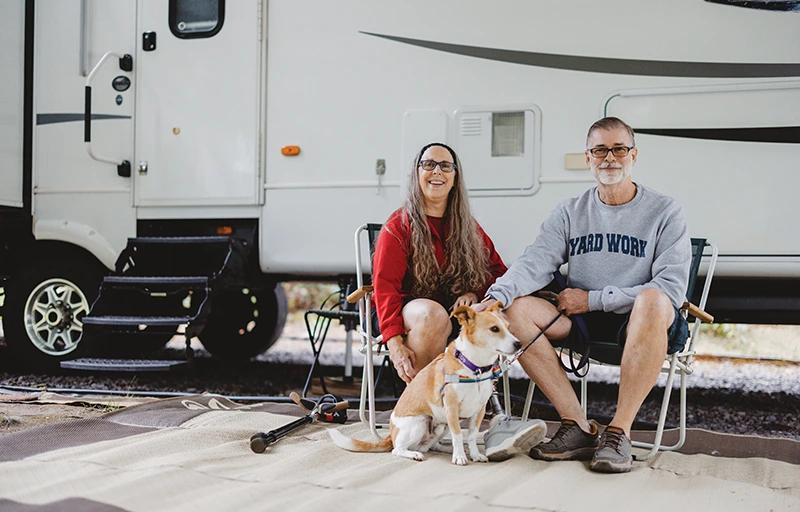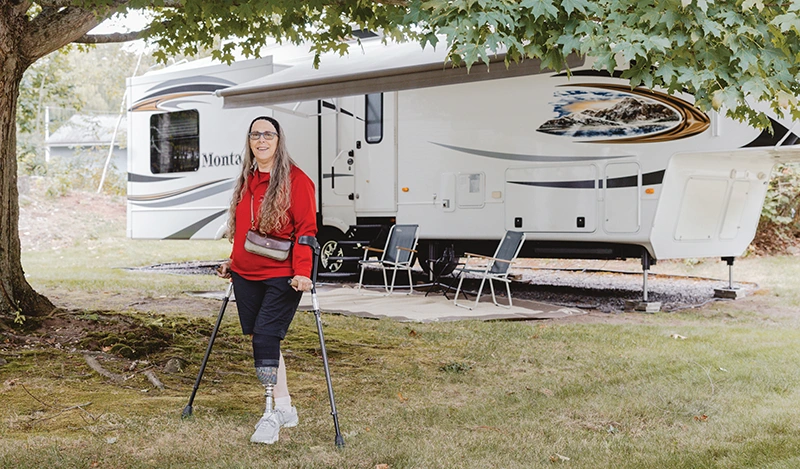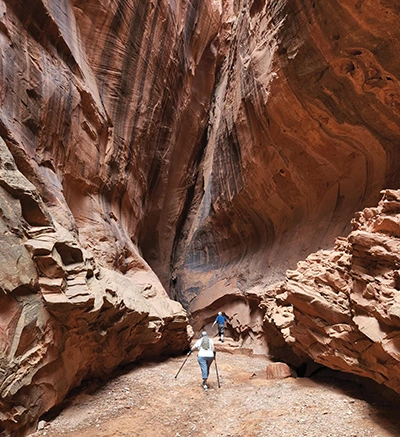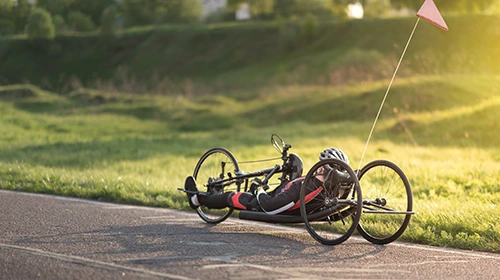By Beth Hudson

After the motorcycle accident that destroyed my left leg in 2017, it took me a few years to figure out how to get outdoor recreation back into my life. I’m not on the Paralympic track team and have no interest in being an elite athlete. I’m not chasing after likes and shares on social media, either. Like most amputees, I just want to keep my middle-aged muscles and brain in working order. That’s why I’ve made physical and mental fitness a part of my everyday routine.
But if you’re like me, that’s easier said than done. In addition to a below-knee amputation, I have a permanent ileostomy and very strange “plumbing,” a cracked sacrum, and major muscular and neuromuscular damage to my upper left leg. Those injuries left me with little use of my hamstring, glute, and core, which are all important to walking correctly as an amputee. Lofstrand crutches are my constant companions.
My health challenges forced me to retire after a 36-year teaching career, but they haven’t kept me from finding ways to get out of the house and stay active. I love all kinds of outdoor recreation, from laidback pursuits such as hiking and birdwatching to more adventurous endeavors like kayaking and bicycling. As long as it helps me stay in shape, engages my mental gears, provides some fresh air, and satisfies my need for mobility and speed, I’m there.
The thing that ties it all together is CC, our 40-foot-long recreational vehicle. CC (short for Camping Castle) is just the ticket for getting out of the house and staying as active as my body allows. CC enables me to experience different places, meet all kinds of people, and take on a variety of challenges. In fact, by the time you read this, my husband and I will be in the early stages of an 18-month RV adventure to visit “Anyplace USA.”
It’s all a matter of finding outlets that won’t break your bank or your body. And if I can do it, so can you.
Ready for Anything

My husband and I graduated from tent-based camping to RVing about 20 years ago, long before I lost my leg. For us, RV travel has always been about getting and staying outdoors, relaxing, and taking the time to enjoy whatever comes our way. After my accident, I wasn’t sure I’d ever be able to get back to that lifestyle. CC offered the perfect solution.
It took some adjustment, of course. The first summer after my accident, I needed 20 minutes and assistance from two adults to get up the steps into CC. But now it’s easy-peasy. We stayed fairly close to our New Hampshire home for the first couple of years after limb loss, then gradually widened our circle.
Whether you’re visiting a place in your backyard or driving far afield, it doesn’t take long to see the beauty around you. Earlier this year we had some amazing experiences in Estes Park, Colorado—nothing like elk walking through your campsite and moose crossing your path on a hike. Bryce Canyon National Park in Utah was equally spectacular, with hoodoos galore, magnificent night skies, and accessible biking and hiking trails.
Whatever our destination, I always do a bit of advance research and set a goal for myself. For example, last year we went to Gettysburg, which has an eight-story-high observation tower overlooking the battlefield. My goal was to climb it. It took me a few extra minutes, with frequent stops on the landings along the way, but I succeeded, and it was sweet. When we camped on the banks of the Chesapeake last summer, my goal was to walk a half-mile on the beach, with my sand claws attached to my SideStix. In Estes Park, my husband and I hiked two one-mile trails in two days—beautiful lake loops with moose, elk, marmots, Canada geese, and the fattest squirrels I have ever seen. Being at 7,000-plus feet in altitude did a number on me, and the next day was a rest day, but it was totally worth it.
No matter what goal I set, I break it down into smaller parts. Starting with small, attainable goals will help you feel a sense of accomplishment and keep you from getting discouraged. And discouragement totally defeats the purpose—the point is to feel the joy of being outdoors. As you get stronger, you can always set more ambitious goals. But start with something realistic.
Safety also plays a central role in my travel planning. I always make reservations for every night in a campground or RV park—when you’re hungry and tired, it’s no fun driving around and hoping there’s a place to stay right around the bend. I store as much food as possible in CC’s freezer, and we always have a meal that can be eaten out of a can if necessary. And we pack methodically and bring emergency supplies, especially for medical issues. I always bring a walker with me, extra meds, and plenty of amputee and ostomy supplies. When we first resumed RVing after my limb loss, I brought my wheelchair.
What we bring most of is patience, however, because things will inevitably go wrong. Flexibility and preparation are the keys. Earlier this year, on our way to Bryce Canyon, we spent one night parked behind a country store with no electricity or water hookups. It was cold, and our generators could not keep up. Later, we found a campground nearby and were much more comfortable there. Moral of the story? Always have a plan B.
RV TRAVEL
- The Handicapped Travel Club is a 50-year-old organization that promotes RV travel for people with disabilities. It includes a guide to accessible RV makes and models. handicappedtravelclub.com
Paths of Least Resistance

One of the best parts of any RV outing is finding a good place to hike. In truth, my hikes are more like walks in the outdoors, and I’m fine with that. You don’t have to walk miles into the wilderness to find breathtaking beauty. In Colorado’s Rocky Mountain National Park this summer, I did three one-mile loops: Bear Lake, Sprague Lake, and Lily Lake, which are all wheelchair accessible. (Sprague Lake has a wheelchair-accessible backcountry campsite—very cool!) I’ve also taken some excellent hikes in botanical gardens and arboretums that feature gardens galore, with benches everywhere.
My pace is between a snail’s and a turtle’s, about one mile an hour. I rarely hike for more than an hour at a time because I walk with cuff crutches. There’s no shame if you don’t finish the trail. When we tried the Mossy Cave Trail in Escalante, Utah, this summer, I needed both my husband’s and my brother-in-law’s help walking up the hill to the trailhead. I made it along the riverbank and across two beautiful bridges, but after that the trail climbed at about a 10 percent grade—no joy for me in 90-degree heat at an altitude of 8,000 feet. I knew my limits and didn’t push them, and as a result I still very much enjoyed the experience.
I also knew ahead of time that I’d be stopping at that point, because I consulted a trail app in advance. A good app such as AllTrails will tell you not only the route’s complete distance but also the elevation profile. If there are steep inclines and declines, I can either plan around them or look for an easier trail. I also check the surface. I do fine on paved or packed-gravel trails, but loose gravel and sand are tough for me. It’s also helpful to know in advance if I’ll be crossing water, and whether it’s a loop trail or an out-and-back.
Clothing should match the weather, and if there are ticks in the area wear long pants even if it’s hot. Add sunscreen and bug spray to your backpack. Shoes are so very important; many lower-limb amputees can’t wear ankle hiking boots, so a good pair of walking shoes is a must. Hiking poles can also help with your balance, and they’re handy on inclines as well. If you decide that hiking is something you like, I heartily endorse buying a good pair.
Whenever I hike, I have a dedicated backpack that contains one-, three-, and five-ply socks, wipes, and a small bottle of ALPS silicone lotion. Ostomy supplies, a small first-aid kit, a mirror, a whistle, and a poncho round things out. Except for fresh water in the hydration bladder and a snack, my daypack is always ready to go, and it always comes with me, no matter the activity—hiking, biking, birding, or anything else. Finally, I never go hiking alone. Always better safe than sorry—always.
FINDING A TRAIL
- AllTrails gives you an overhead map of the route along with the elevation profile, so you can anticipate or avoid difficult inclines. alltrails.com
- TrailLink is focused on rails-to-trails paths. Because these are former railroad grades, the trails tend to be reasonably flat and well maintained. traillink.com
On the Wing

When we travel by RV, birdwatching is a big part of the experience. Whether I’m hiking, biking, or hanging out in front of CC under the awning, I’m always on the lookout. It’s emotionally relaxing and good for the soul.
My bird list is fairly short, but it’s growing rapidly now that I’m traveling more extensively. In Colorado this year, I added the magpie, and in Utah, I spotted a western bluebird, which I had seen only once before. During our trip west, we saw six sandhill cranes take off in unison—what a magnificent sight. The same goes for bald eagles. At the top of my list, though, is the indigo bunting. It looks black until the sun hits it, then it becomes bright blue—magnificent. I have seen two.
Seeing and identifying new birds is emotionally uplifting, but I find as much beauty in the common species as the uncommon. The call of the loon, with its black bespeckled body, never gets old for me. Sparrows, robins, finches, and jays all have a place in the balance of nature, and you can enjoy them from almost anywhere. In fact, if you aren’t quite ready to get out of the house for an excursion yet, bird feeders are a great way to get into birding. Some can be attached to a window using suction cups, and they’re a great way to see birds up close. Different types of feeders and seeds will attract different species. (Squirrels and chipmunks will also partake.) Orioles migrate past my area, but if I want them to stop, I need to cut an orange in half, put it on a spike, and hang it out on my feeder.
When I leave home to travel to a new area, I do some research ahead of time, so I know what birds to look for and where they’re most commonly seen. That information might help me decide where to hike, bike, or park CC. Bird books and apps are excellent resources. The Audubon Society, state wildlife departments, and park rangers are other great sources of information. Any body of water will probably have birds of some sort nearby, and migratory birds follow regular pathways that bring them to the same places at predictable times of year.
I usually look for birds whenever I hike, but I’m always careful about it. For those who have balance issues or, like me, need to look down at the terrain because of the use of walking aids, stop before you look up. Find a decent pair of binoculars that won’t weigh down your neck or hinder your balance. And in our cellphone-camera-happy era, try to resist the temptation to turn every sighting into a photo op. Enjoy the sight as it unfolds. Fortunate is the birder who sees a bird willing to sit still long enough for a portrait.
ACCESSIBLE BIRDING
- Birdability includes tips for accessible bird-watching, including a crowd-sourced map of disability-friendly trails and locations. Created in partnership with the National Audubon Society. birdability.org
- Many regional and local Audubon Society chapters have specific programs for accessible birding. Check the national organization’s website to find the chapter nearest you. audubon.org
Ticket to Ride

Bicycling is another regular feature of my journeys with CC. I ride a recumbent because, like many other amputees, I have balance issues. It took some doing to get my model (a BerkelBike Pro, which combines foot-pedal and handcycle options) to fit in the belly of our RV, but it has been worth the trouble. On a recent Colorado ride, my husband and I saw a bald eagle soaring overhead with dinner in its talons. Awesome doesn’t begin to describe that experience!
As with hiking, it’s important to scout out trails before you go and choose one that fits your abilities. Relatively level, scenic bike paths can be found just about everywhere, from the city to the suburbs to the countryside. If you’re not doing a loop, make sure you pace yourself and leave enough energy in the tank to ride all the way back. For me, a route’s elevation difference is one of the most important considerations. Steep inclines are out unless I have a place to rest. Near Bryce Canyon this summer, I set out on a 12-mile ride through Red Canyon, aptly named for its red rock formations. My aspirations exceeded my abilities, or so I thought at first. We climbed steadily for nearly eight miles on a very hot, cloudless day. But after a much-needed break for food, water, and rest, we were rewarded with four miles of downhill through the canyon. Phantom pains ensued that night, but it was worth it.
We also did a three-mile ride on the rim of Bryce Canyon that week. It was stunningly beautiful, and the forest provided cooler temps. You can’t pedal through the canyon itself, but there’s another way to ride down there: on horseback. Because of my pelvic and back issues, it wasn’t a good choice for me, but Mr. Better Half went with the family, and the pictures were fabulous.
Just being around horses can be food for the soul; animals don’t judge. And adaptive riding is more accessible than you might think. Many amputees (both upper- and lower-limb) have taken up riding after limb loss. I haven’t tried it, but before my accident I went on guided trail rides in several places and always enjoyed it. I’m not an experienced rider, but all I had to do was let my horse follow the one in front of it. I really didn’t have to steer; a gentle kick to get the horse started and a “Whoa!” to stop it was all it took.
Physically, riding will increase strength and endurance of all the muscles needed to walk for lower-extremity amputees, and it can help increase range of motion for upper-extremity amputees. But for many adaptive riders, connecting with the animal is the core benefit of the experience. Rubbing a horse’s nose and petting its neck allows you to forget your struggles for a bit.
That’s what I’m always after when I spend time outdoors. Being out in nature takes my focus away from life’s challenges and helps me appreciate life’s pleasures. So just get out there, however you can—via crutches, bicycle, wheelchair, RV, or anything else. Remember: If I can do it, so can you!
BICYCLING
- Cycling With Disabilities is a welcoming, active Facebook group that has more than 2,500 members. It’s a great source of info about trails, destinations, equipment, and more.
- The Adventure Cycling Association offers tips and information for cyclists of all ages and ability levels. adventurecycling.org
HORSEBACK RIDING
- Destiny’s Ride is an inclusive equestrian program that promotes healing through horseback riding. destinysride.org
Beth Hudson is a retired schoolteacher and an active RV traveler, swimmer, cyclist, and blogger.




